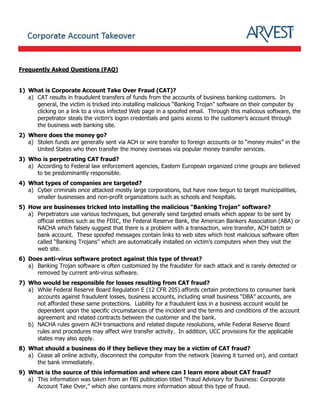
Jon handout 2
- 1. Frequently Asked Questions (FAQ) 1) What is Corporate Account Take Over Fraud (CAT)? a) CAT results in fraudulent transfers of funds from the accounts of business banking customers. In general, the victim is tricked into installing malicious “Banking Trojan” software on their computer by clicking on a link to a virus infected Web page in a spoofed email. Through this malicious software, the perpetrator steals the victim’s logon credentials and gains access to the customer’s account through the business web banking site. 2) Where does the money go? a) Stolen funds are generally sent via ACH or wire transfer to foreign accounts or to “money mules” in the United States who then transfer the money overseas via popular money transfer services. 3) Who is perpetrating CAT fraud? a) According to Federal law enforcement agencies, Eastern European organized crime groups are believed to be predominantly responsible. 4) What types of companies are targeted? a) Cyber criminals once attacked mostly large corporations, but have now begun to target municipalities, smaller businesses and non-profit organizations such as schools and hospitals. 5) How are businesses tricked into installing the malicious “Banking Trojan” software? a) Perpetrators use various techniques, but generally send targeted emails which appear to be sent by official entities such as the FDIC, the Federal Reserve Bank, the American Bankers Association (ABA) or NACHA which falsely suggest that there is a problem with a transaction, wire transfer, ACH batch or bank account. These spoofed messages contain links to web sites which host malicious software often called “Banking Trojans” which are automatically installed on victim’s computers when they visit the web site. 6) Does anti-virus software protect against this type of threat? a) Banking Trojan software is often customized by the fraudster for each attack and is rarely detected or removed by current anti-virus software. 7) Who would be responsible for losses resulting from CAT fraud? a) While Federal Reserve Board Regulation E (12 CFR 205) affords certain protections to consumer bank accounts against fraudulent losses, business accounts, including small business “DBA” accounts, are not afforded these same protections. Liability for a fraudulent loss in a business account would be dependent upon the specific circumstances of the incident and the terms and conditions of the account agreement and related contracts between the customer and the bank. b) NACHA rules govern ACH transactions and related dispute resolutions, while Federal Reserve Board rules and procedures may affect wire transfer activity. In addition, UCC provisions for the applicable states may also apply. 8) What should a business do if they believe they may be a victim of CAT fraud? a) Cease all online activity, disconnect the computer from the network (leaving it turned on), and contact the bank immediately. 9) What is the source of this information and where can I learn more about CAT fraud? a) This information was taken from an FBI publication titled “Fraud Advisory for Business: Corporate Account Take Over,” which also contains more information about this type of fraud.
- 2. Glossary of Terms Banking Trojan – Malicious software that may allow a hacker remote access to a targeted computer system. Once a Banking Trojan has been installed, the hacker may gain remote access to the computer and may be able to perform various operations such as stealing web banking credentials or initiating unauthorized funds transfers. Credentials – Information needed to log into a secure computer system which may include a user name, password or token code. Keystroke logger – Malicious software used to monitor a user's activities by recording every keystroke the user makes with the intent to steal passwords and confidential information. (source: zdnet.com) Malware – (Short for MALicious softWARE) Software designed to compromise computers or computer information. Examples include viruses, worms, spyware and Trojan horse applications such as “banking Trojans.” Money mule - A person who transfers stolen money as a part of a fraudulent scam, either in person, through a courier service or electronically. Money mules may or may not be aware that the money they are transferring is stolen. The stolen funds are generally transferred from the victim's country to the scam operator's country. (source: Wikipedia.org) Phishing – The fraudulent process of attempting to acquire sensitive information such as usernames, passwords and credit card details by masquerading as a trustworthy entity in an electronic communication. (Phishing is a form of social engineering using spoofed email.) Spear phishing – A method of Phishing whereby individuals or businesses are specifically targeted. Social engineering - Manipulating people into performing actions or divulging confidential information by trickery, rather than by physically breaking in or by using technical techniques. Spoofed email - E-mail sent so that the sender’s address and other parts of the message are altered to appear as though the e-mail originated from a different source. The message may incorporate graphics taken from a legitimate entity’s web site to give the appearance of authenticity.
